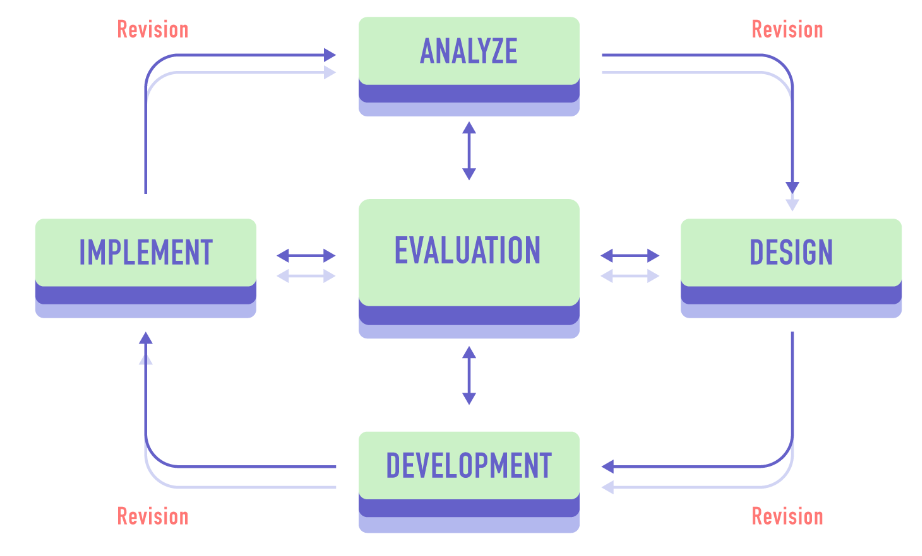The Addie model is an instructional design methodology used to help organize and streamline the production of your course content. Developed in the 1970’s, ADDIE is still the most used model for instructional design. Why? – It’s simple and effective.
Addie is an acronym for the five stages of a development process: Analysis, Design, Development, Implementation, and Evaluation. The ADDIE model relies on each stage being done in the given order but with a focus on reflection and iteration. The model gives you a streamlined, focused approach that provides feedback for continuous improvement.

The 5 Steps of The Addie Process
Step 1: Analysis
Before you start developing any content or training strategies, you should analyse the current situation in terms of training, knowledge gaps, etc. Start with a series of questions to understand the current situation and the goal of the training itself. This influences a huge number of decisions later in the process.
One very common question is: What is the point of the training? Why are we doing it? What type of behavioural change is desired? Will training actually help? This phase should be a full audit of the audience, business goals, training methodologies used, media types used, etc. Once this is done, you can generate a training plan that addresses:
Who, What, When, Where, why, and how?
The core of your training plan will be, “How can we improve the situation and achieve business goals through training?”. You will use this question as the foundation for the rest of the process. You should come out with an analysis of training needs and a training plan.
Step 2: Design
With your training plan done, you then get to the design phase – this is where you take all of the learnings of the previous phase and use it to make practical decisions. This includes a strategy, delivery methods, structure, duration, assessment, and feedback. The next step is to storyboard your ideas and/or create a prototype. You are creating a blueprint for your courses, and by making a prototype you can quickly communicate with other stakeholders the value of the training.
An initial testing phase of the prototype is always a good idea, this is a sanity check that is carried out prior to moving too far forward.
You should come out with an overview of the course design and storyboards/prototypes.
Step 3: Development
At this stage, you can begin to create the courses. You will be heavily guided by the prototype/storyboards at this point. Each element of the course should be developed to match the design phase. The core of the content has already been decided. All you need to add is a level of detail and polish to the courses.
The development process should be iterative. Once you have created a course you should test it to ensure there are no basic errors – grammar, spelling, syntax etc.
You should come out with: Course Content
Step 4: Implementation
Once you have completed your courses and you are satisfied that they are fully tested, it’s time to share them with the learner. The decisions made in the design phase will influence how this is actually carried out. In the majority of cases, the courses are uploaded to an LMS, and the delivery options are set up – who are enrolled, how much time are they given, pass marks for assessments, and the collection of feedback.
The instructional designer should monitor the situation for any teething issues. One of the best was to prevent against any problems in the implementation phase is to conduct a pilot of a course before unleashing the content on the entire group.
You should come out with: Your courses are live in the LMS, and learners can start to take and complete courses.
Step 5: Evaluation
ADDIE’s main goal is to provide a structured method of creating training programs. It is also, however, a powerful model for improving the way in which future iterations are created. Getting feedback on every aspect of the courses is really important so that you can improve and revise the content. What to focus on:
- Did we meet the goals as set out in the analysis phase?
- Take feedback and place back into the analysis phase.
- Identify other training requirements.
- Possible change in media types or approach.
A great way to get feedback is to ask learners to complete surveys at the end of their course. Create survey questions specific to the points above but also encourage learners to give feedback in a free text box so that you are aware of any gaps you may not have thought of.
Benefits of the ADDIE Model:
- Systematic Approach: The ADDIE model provides a structured and systematic approach to instructional design, ensuring that all important aspects of the learning process are considered and addressed.
- Flexibility: While the ADDIE model follows a linear sequence of phases, it also allows for flexibility and iteration. Designers can revisit earlier phases as needed based on feedback and evaluation data.
- Focus on Learner Needs: By emphasizing analysis and evaluation, the ADDIE model ensures that instructional interventions are tailored to the needs of the learners and the specific learning context.
Implementation Challenges and Best Practices:
- Time and Resources: Adequate time and resources are required for each phase of the ADDIE process. Designers should allocate sufficient time and budget to ensure quality outcomes.
- Stakeholder Involvement: Collaboration and communication with stakeholders, including subject matter experts and learners, are critical for the success of the ADDIE process.
- Continuous Improvement: Continuous evaluation and iteration are essential for improving the effectiveness of instructional interventions over time. Designers should seek feedback and use evaluation data to inform future design decisions.